Bulletin – December 2011 Insights from the Household Expenditure Survey
- Download the article 1.0MB
Abstract
This article uses information from the latest Household Expenditure Survey to examine recent expenditure patterns. The period between 2003/04 and 2009/10 was characterised by strong real household income growth and falling relative prices of goods due to the appreciating exchange rate. These developments have provided extra resources to households for spending on discretionary services, which are taking a larger share of household spending over time. There was also an increase in expenditure on housing, which was associated with rising dwelling prices and higher levels of debt.
Introduction
There have been significant changes in the composition of consumer spending over recent decades, with the most prominent being the gradual shift in expenditure away from goods towards services. At the beginning of the 1960s the share of expenditure on services was around 40 per cent; today this share is around 60 per cent (Graph 1).
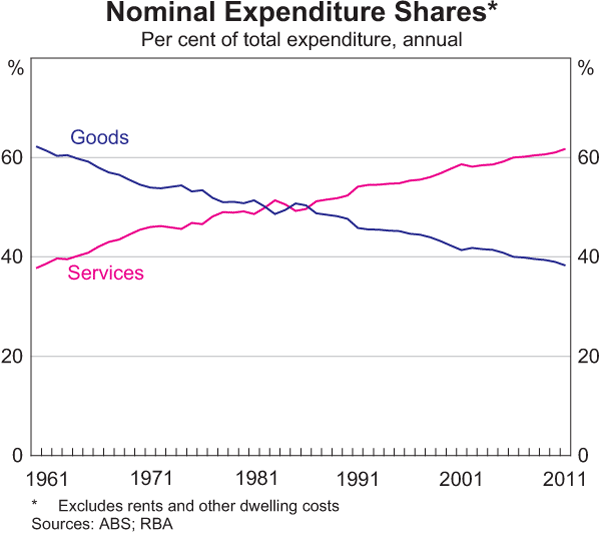
Detailed information on expenditure patterns comes primarily from the Household Expenditure Survey (HES) conducted by the Australian Bureau of Statistics (ABS) about twice a decade, with the latest survey undertaken in 2009/10. This article uses this survey to examine changes in expenditure patterns over time as well as across households at given points in time.
Data
The 2009/10 HES data are based on a nationally representative sample of adults in around 10,000 households. The survey collects information on how households allocate resources across a selection of around 600 goods and services and surveys a range of socio-demographic characteristics for each household.
The ABS uses two methods to collect expenditure data: the ‘diary’ method; and the ‘recall’ method. The diary method is used for regular expenditures; households are issued with an ‘expenditure diary’ and asked to record all their expenditures over a fortnight. For items that are expensive or infrequently purchased, such as cars and washing machines, the recall method is used with households asked to remember how much they spent on these items. Recall periods vary for different items and are generally longer for more expensive/infrequently purchased items where households are more likely to remember the amount spent. For example, the recall period for furniture and appliances is over the previous three months while for the purchase of a dwelling it is over the previous three years.
The HES is a particularly rich data source. Because household-specific factors – such as demographic and social characteristics – are unobservable in aggregate statistics, their relevance can only be assessed with household-level data.
The HES is also used to update expenditure weights in the consumer price index (CPI). Absent any reweighting, items with relative price falls would have declining weights in the CPI. Among other things, the reweighting accounts for the response of households to price falls; households typically consume more of items which have experienced relative price declines.[1]
For this article the 600 plus expenditure items are mapped into five categories: non-durable goods; durable goods; essential services; discretionary services; and dwelling costs (Appendix A provides details of the composition of each expenditure type). The article examines the change in expenditure shares over 2003/04 to 2009/10 across different demographic characteristics and with reference to changes in relative prices. The variation in expenditure among households at given points in time is then used to classify all of the expenditure items as either ‘superior’, ‘normal’ or, in very rare cases, ‘inferior’ goods or services.
Changes in Consumer Expenditure Patterns
Since 2003/04 there has been a pattern of expenditure being reallocated away from goods towards discretionary services and housing.
Graph 2 shows the changes in expenditure share for each of the five categories described above (which taken together sum to zero) and the biggest contributors to this change within each category. Increases in the share of expenditure on discretionary services and housing have coincided with a decline in the expenditure share on both durable and non-durable goods, while the share of essential services has been broadly unchanged. Within the expenditure categories, there has been a decline in the expenditure share allocated to durable and non-durable goods such as vehicles, furniture, food & drink and tobacco. Within the discretionary services category, there have been particularly large increases in expenditure on sports participation, holiday travel and restaurant meals.
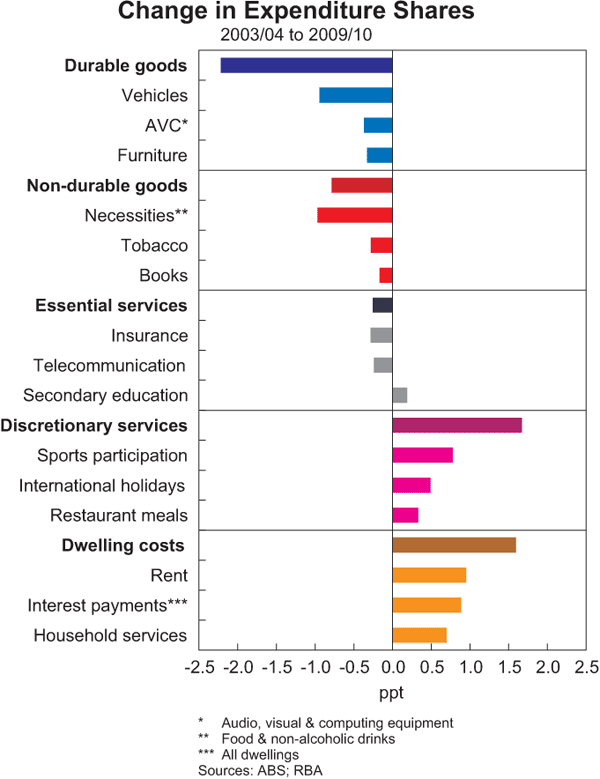
Rising real household income is likely to have been a factor affecting the shift towards discretionary services. For instance, the increased expenditure share of restaurant meals and broader ‘catering services’ is related to a higher propensity for both males and females to be participating in the workforce; as more household members participate in the workforce the demand for catering services, which includes meals eaten out and school tuckshop lunches, is likely to rise.
This reallocation of expenditure away from both durable and non-durable goods towards services is widespread across income groups and education groups.[2] While higher-income households have higher expenditure shares on discretionary services, across all groups there have been rises in the share of expenditure on discretionary services (Graph 3). However, the largest increases have been for higherincome households. For example, households in the highest income group boosted their expenditure share on discretionary services from around 13 per cent to 16 per cent from 2003/04 to 2009/10, an increase around twice as large as for middle-income households, whose expenditure share rose from 10 per cent to 11.5 per cent over this period.
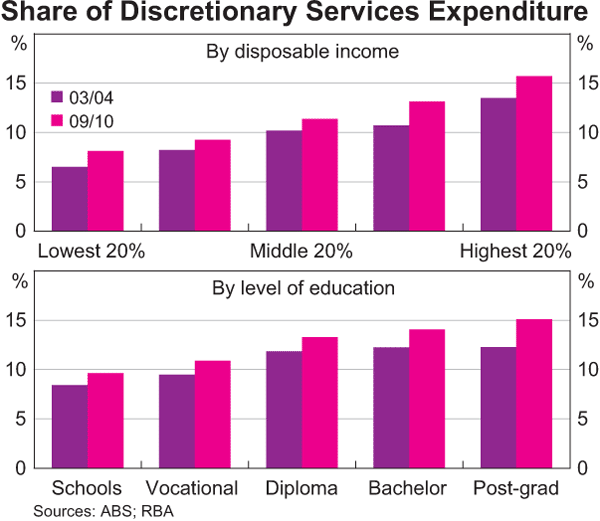
The Effects of Relative Price Changes
This shift in expenditure shares has taken place alongside a fairly large movement in relative prices over recent years. In particular, the prices of tradables (typically goods) have fallen significantly relative to non-tradables (typically services). While over long periods of time the prices of goods tend to increase less quickly than the prices of services due to faster productivity growth in the production of goods, the difference has been bigger than usual over the past decade. In large part, this reflects the appreciation of the Australian dollar which has reduced the prices of many imported manufactured goods (Graph 4).
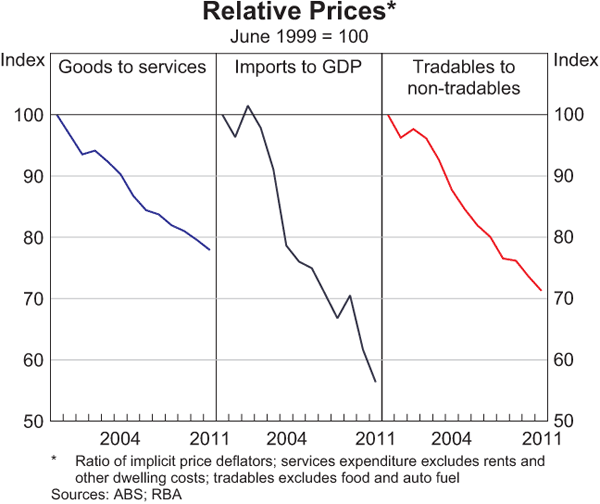
These changes in relative prices have had an impact on expenditure patterns, with consumers tending to substitute away from goods and services where relative prices have increased and towards those where relative prices have declined (although the extent of substitution varies significantly across goods and services). These effects can be seen when expenditure shares are broken down into price and quantities by combining consumer prices data with the HES. Graph 5 shows the change in relative prices and quantities demanded for a broad set of goods and services.[3] There is a clear negative correlation between these variables, with the regression line showing the relationship between price increases and quantities demanded.
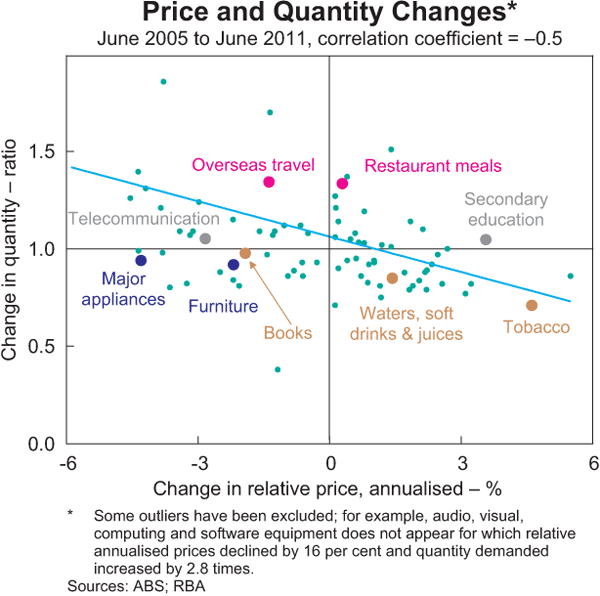
The Effect of Growth in Incomes
Change in incomes can also have a significant effect on spending patterns. Real per capita income grew by around 2.7 per cent per annum between the HES in 2003/04 and 2009/10. This growth in incomes allowed considerable additional spending on discretionary services and housing. For example, purchases of restaurant meals and personal services (such as haircuts) increased more than for other goods and services despite an increase in their relative price.
Further insights into the role of rising incomes can be obtained by examining how spending on different goods and services changes with income or overall spending in a cross-section of households. In particular, the way that demand for any particular good or service changes across households can be analysed by estimating ‘Engel curves’ from the HES survey. The Engel curve describes how households' purchases of goods and services vary with differences in their total resources such as income or total expenditures.[4]
Graph 6 illustrates this relationship with data for two broad groups of spending based on the expenditure patterns of around 10,000 households in the 2009/10 HES. The top panel shows the share of total expenditure on food and non-alcoholic drinks expenditure (i.e. necessary expenditures) while the bottom shows the share spent on discretionary goods and services. The share of expenditure on necessities decreases as households' spending capacity increases while for discretionary items the opposite is the case. This relationship is known as Engel's law: the share of expenditure on necessities, such as food, decreases with increasing spending capacity (see, for instance, Lewbel (2008)). The corollary of this law is that the share of expenditure on discretionary items (which includes things like the theatre and sports lessons) rises with increasing spending capacity.
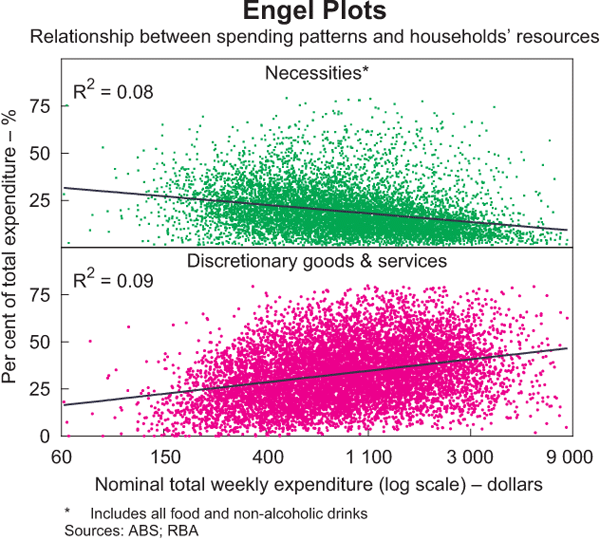
Households' spending capacity can, however, explain only a small proportion of the variation in spending on these items across individual households. For example, fitting a regression line through the share of spending on these categories and total expenditure for each household explains only 8–9 per cent of the variation in expenditure shares between households. However, controlling for some observed differences between households increases the amount of variation that can be explained to around 20 per cent for both categories. This occurs when age, the number of people in the household, tenure type (i.e. whether the household is renting, paying off a mortgage or owns its dwelling outright), whether the household lives in a capital city, and employment status are taken into account.
Engel curves can also be used to better understand the demand for goods and services at a much more detailed level. In particular, the estimated relationship between demand and total expenditure can be used to derive expenditure elasticities of demand for individual goods and services. These elasticities describe the percentage change in the quantity purchased of any given good or service that results from a 1 per cent change in total expenditures on goods and services. In other words, the elasticity measure shows how sensitive average expenditure on a particular good or service is relative to households' total expenditure.
Estimates of expenditure elasticity are obtained from estimating the following equation:

where
![]() is household
i's expenditure sihare on goods or services category g,
Ei is total expenditure and Di captures
various demographic variables (such as age of the household head and the number
of people in the household). The expenditure elasticity is given by:
is household
i's expenditure sihare on goods or services category g,
Ei is total expenditure and Di captures
various demographic variables (such as age of the household head and the number
of people in the household). The expenditure elasticity is given by:

where
 is the median expenditure
share on goods or services category g.
is the median expenditure
share on goods or services category g.
The resulting expenditure elasticities of demand can be used to classify goods and services into different categories. Goods and services with elasticities that are positive but less than unity are considered to be normal; as households' total expenditure on all goods and services increases, expenditure on normal goods and services increases, though the budget share does not rise. Goods and services with elasticities above unity are classified as superior, with households' expenditure on these goods and services increasing more than proportionately with any increase in total expenditure. Inferior goods and services are seldom observed and are those which have a negative elasticity; the level of expenditure on inferior goods declines declines as households' spending capacity increases.
Based on estimates for the approximately 600 goods and services from the 2009/10 HES, just over half of household spending was on normal goods and services. Food and drink items tend to be normal goods with the exception of alcoholic beverages which are superior. Many durable goods and most essential services are also estimated to be normal goods.
Almost all of the remainder of spending in 2009/10 was on goods and services that are estimated to be superior. For example, almost all the service items classified as discretionary services in Appendix A are estimated to be superior (with the exception of takeaway and fast foods). In addition, there are a wide range of durable goods estimated to be superior goods. For example, among the numerous expenditure items which map into the 23 durable goods shown in Appendix A, boats, camping equipment, jewellery, photographic equipment and audio equipment are superior goods.
Less than 1 per cent of total spending was on goods and services that were estimated to be inferior goods in 2009/10. Given that many of these have elasticities only slightly less than zero, it is difficult to be definitive. However, based on the data from the 2003/04 and 2009/10 HES, examples of goods which may be classified as inferior goods are powdered milk, TV rental and tobacco other than cigarettes.
The information about elasticities can be aggregated across the four main expenditure categories – comprising non-durable goods, durable goods, discretionary services and essential services – over the past three HES surveys (Graph 7).[5] Over a decade ago, durable goods had the characteristics of superior goods. However, as incomes have risen and relative prices of these goods have declined, durables now have characteristics closer to normal goods. In contrast, discretionary services have become more superior, which helps explain why households are spending an increasing share of their resources on them as real incomes have grown strongly. Moreover, regressions suggest that services classified as superior in the 2003/04 HES tended to experience increased demand by households over the 2003/04 to 2009/10 period. This relationship did not, however, hold for durable goods, with the degree of superiority having no explanatory power for the change in demand between 2003/04 and 2009/10. One explanation would be that for some households, there has been a satiation in demand for durable goods.
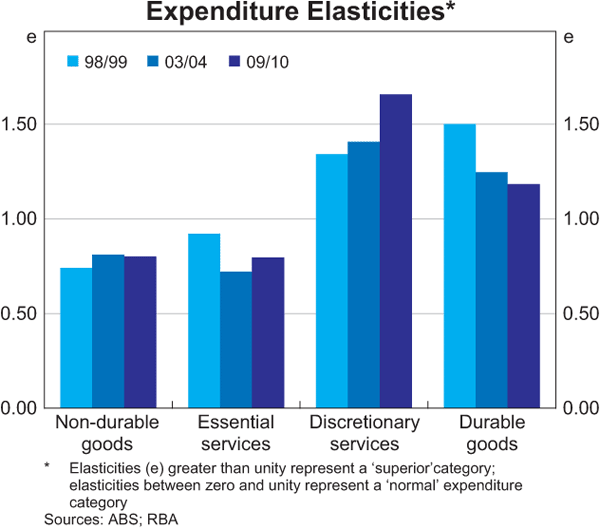
Expenditure on Housing
There was a significant increase in the share of spending on the broad housing category between the 2003/04 and 2009/10 HES Surveys.[6] The increase largely reflects the rise in interest payments on mortgage debt and rising rents (Graph 2). These increases were, however, offset to some extent by a falling expenditure share on new dwelling purchases by owner-occupiers; the decline is consistent with the fall in the number of private dwelling completions over the same period.
The increase in the share of expenditure on mortgage interest payments reflects the
rise in housing prices and the associated increase in mortgage debt of the
household
sector.[7]
Nationwide, dwelling prices increased by around 19 per cent relative to the
CPI over this period with the aggregate housing debt-toincome ratio (which
conceptually averages over all households including those without mortgage
debt) increasing from 79 per cent in 2003/04 to 98 per cent
in
2009/10.8.[8]
This increase partly reflects a rise in the share of the population with mortgages
over this period. This change has largely been driven by the increased propensity
for older households to remain in debt for longer and an increase in the number
of households with investment properties, which has resulted in a decline
in the share of those households who own their dwelling outright (Table 1).
| 2009/10 Per cent | Change: 2003/04 to 2009/10 Percentage points | |||||
|---|---|---|---|---|---|---|
| Renters |
Has mortgage |
Owns outright |
Renters |
Has mortgage |
Owns outright |
|
| 29.3 | 37.2 | 33.5 | 1.1 | 1.2 | −2.3 | |
|
(a) Share of all renters, households with mortgage debt and outright owners Sources: ABS; RBA |
||||||
Reflecting the increase in real housing prices and in mortgage debt, the expenditure share on housing has risen for households with a mortgage. There has been an increase across all groups in the housing debt-to-income ratio for households with a mortgage. The largest increase has been for younger households (those under 39 years of age). This is consistent with young households (who have mortgages) increasing their expenditure share on housing by the most (Table 2).
| Age of household head(a) |
Expenditure shares(b) |
Median housing debt-to-income |
||||||||||
|---|---|---|---|---|---|---|---|---|---|---|---|---|
| 2009/10 Per cent |
Change from 2003/04 to 2009/10 Percentage points |
2009/10 Ratio |
Change from 2003/04 to 2009/10 Per cent |
|||||||||
| Renters |
Has mortgage |
Renters |
Has mortgage |
Has mortgage |
Has mortgage |
|||||||
| 15 to 39 | 27.8 | 29.3 | 3.1 | 4.2 | 333 | 29 | ||||||
| 40 to 59 | 29.5 | 21.2 | 2.1 | 2.0 | 211 | 14 | ||||||
| 60 and over | 34.4 | 18.4 | −0.3 | 0.6 | 159 | 20 | ||||||
|
(a) The household head is the person most likely to be making financial
decisions for the household Sources: ABS; RBA |
||||||||||||
There has also been an increase in rents as a share of total household expenditure reflecting an increase in the proportion of the population renting as well as the cost of rent rising in real terms between 2003/04 and 2009/10 (the ABS measure suggests an annual real increase in all rents of around 2 per cent for the stock of public and privately owned rental properties, while the REIA measure suggests an increase of 5 per cent for newly negotiated rents). The share of housing in total expenditure is typically higher for renters than for households with mortgages across the age distribution, with the largest increase in the expenditure share on housing having been for young households. Accordingly, consistent with Richards (2008), the increase in the cost of housing has affected younger households, whether renters or purchasers, more than other age groups.
Conclusion
The HES is a useful source of information on the expenditure of Australian households at the micro level. This article has used the data obtained from the HES over three consecutive waves to examine household-level changes in expenditure shares and the heterogeneity of spending patterns by household characteristics. The growth of services spending has substantially outpaced that of spending on both durable and non-durable goods. This observation holds across the various breakdowns of households examined. Over a decade ago, durable goods had the characteristics of superior goods. However, as incomes have risen and relative prices of these goods have declined, durables now have characteristics closer to normal goods. In contrast, discretionary services have become more superior, partly explaining why households are spending an increasing share of their resources on them. Expenditure on housing has risen, with the youngest households increasing their housing expenditure share by the most.
Appendix A
| Expenditure item | Mean expenditure share: 2009/10 Per cent |
Change in shares: 2003/04 to 2009/10 Percentage points |
Elasticities: 2009/10 |
Classification | ||
|---|---|---|---|---|---|---|
| Non-durables | 27.45 | −0.81 | ||||
| Bread | 1.07 | −0.10 | 0.83 | Normal | ||
| Cakes & biscuits | 1.19 | −0.02 | 0.84 | Normal | ||
| Breakfast cereals | 0.44 | −0.02 | 0.45 | Normal | ||
| Other cereal products | 0.21 | 0.01 | 0.43 | Normal | ||
| Beef & veal | 0.80 | −0.08 | 0.69 | Normal | ||
| Pork | 0.75 | −0.08 | 0.65 | Normal | ||
| Lamb & goat | 0.59 | −0.05 | 0.71 | Normal | ||
| Poultry | 0.80 | −0.03 | 0.64 | Normal | ||
| Other meats | 1.33 | −0.05 | 0.88 | Normal | ||
| Fish & other seafood | 0.42 | −0.03 | 0.70 | Normal | ||
| Milk | 0.61 | −0.13 | 0.33 | Normal | ||
| Cheese | 0.37 | 0.01 | 0.59 | Normal | ||
| Ice cream & other dairy products | 0.99 | 0.06 | 0.92 | Normal | ||
| Fruit | 1.43 | −0.08 | 0.85 | Normal | ||
| Vegetables | 1.66 | −0.07 | 0.76 | Normal | ||
| Eggs | 0.13 | −0.01 | 0.47 | Normal | ||
| Jams, honey & spreads |
0.18 | −0.02 | 0.50 | Normal | ||
| Food additives & condiments |
0.36 | −0.01 | 0.59 | Normal | ||
| Oils & fats | 0.24 | −0.01 | 0.48 | Normal | ||
| Snacks & confectionery | 1.15 | −0.11 | 0.60 | Normal | ||
| Other food products | 1.01 | −0.03 | 0.80 | Normal | ||
| Coffee, tea & cocoa | 0.34 | 0.00 | 0.59 | Normal | ||
| Waters, soft drinks & juices | 0.89 | −0.12 | 0.63 | Normal | ||
| Spirits | 0.71 | 0.01 | 1.38 | Superior | ||
| Wine | 0.90 | 0.04 | 1.56 | Superior | ||
| Beer | 1.31 | 0.02 | 1.10 | Superior | ||
| Tobacco | 1.22 | −0.28 | 0.19 | Normal | ||
| Garments for men | 1.52 | 0.20 | 1.71 | Superior | ||
| Garments for women | 2.06 | 0.25 | 1.60 | Superior | ||
| Garments for infants & children | 0.76 | 0.09 | 1.52 | Superior | ||
| Footwear for men | 0.25 | 0.01 | 1.55 | Superior | ||
| Footwear for women | 0.33 | 0.00 | 1.47 | Superior | ||
| Footwear for infants & children | 0.22 | 0.06 | 1.47 | Superior | ||
| Cleaning, repair & hire of clothing & footwear | 0.31 | −0.05 | 1.25 | Superior | ||
| Books | 0.81 | −0.17 | 0.82 | Normal | ||
| Newspapers, magazines & stationery | 0.09 | −0.02 | 1.45 | Superior | ||
| Durables | 23.55 | −2.22 | ||||
| Furniture | 1.12 | −0.33 | 1.64 | Superior | ||
| Carpets & other floor coverings | 0.23 | −0.14 | 1.78 | Superior | ||
| Household textiles | 0.53 | −0.03 | 1.71 | Superior | ||
| Major household appliances | 0.72 | −0.10 | 1.27 | Superior | ||
| Small electric household appliances | 0.23 | −0.02 | 1.29 | Superior | ||
| Glassware, tableware & household utensils | 0.59 | −0.01 | 1.25 | Superior | ||
| Tools & equipment for house & garden | 0.51 | −0.08 | 1.40 | Superior | ||
| Cleaning & maintenance products | 0.36 | −0.04 | 0.64 | Normal | ||
| Personal care products | 1.08 | −0.11 | 0.80 | Normal | ||
| Other non-durable household products | 1.95 | 0.05 | 1.10 | Superior | ||
| Therapeutic appliances & equipment | 0.21 | −0.02 | 1.46 | Superior | ||
| Motor vehicles | 2.40 | −0.94 | 2.14 | Superior | ||
| Spare parts & accessories for motor vehicles | 0.73 | −0.01 | 1.20 | Superior | ||
| Automotive fuel | 3.51 | −0.17 | 0.79 | Normal | ||
| Maintenance & repair of motor vehicles | 1.00 | −0.13 | 1.90 | Superior | ||
| Other services in respect of motor vehicles | 1.62 | −0.03 | 0.83 | Normal | ||
| Audio, visual & computing equipment | 1.58 | −0.37 | 1.26 | Superior | ||
| Audio, visual & computing media & services | 1.02 | −0.02 | 0.86 | Normal | ||
| Equipment for sports, camping & open-air recreation | 0.54 | 0.01 | 2.03 | Superior | ||
| Games, toys & hobbies |
1.20 | 0.09 | 1.31 | Superior | ||
| Pharmaceutical products | 0.49 | 0.03 | 1.60 | Superior | ||
| Accessories | 1.38 | 0.13 | 0.77 | Normal | ||
| Pets & related products | 0.55 | 0.02 | 0.52 | Normal | ||
| Essential services | 13.31 | −0.24 | ||||
| Child care | 0.36 | 0.07 | 1.14 | Superior | ||
| Medical & hospital services | 2.83 | −0.06 | 1.19 | Superior | ||
| Dental services | 0.50 | −0.05 | 1.16 | Superior | ||
| Urban transport fares | 0.56 | −0.02 | 0.71 | Normal | ||
| Postal services | 0.14 | −0.01 | 0.86 | Normal | ||
| Telecommunication equipment & services | 3.59 | −0.24 | 0.54 | Normal | ||
| Preschool & primary education | 0.45 | 0.14 | 1.45 | Superior | ||
| Secondary education | 0.68 | 0.19 | 1.63 | Superior | ||
| Tertiary education | 0.64 | 0.02 | 1.66 | Superior | ||
| Insurance | 3.56 | −0.28 | 0.71 | Normal | ||
| Discretionary services | 11.46 | 1.65 | ||||
| Domestic holiday travel & accommodation | 1.90 | 0.06 | 1.76 | Superior | ||
| International holiday travel & accommodation | 1.75 | 0.49 | 1.78 | Superior | ||
| Veterinary & other services for pets | 0.35 | −0.02 | 1.40 | Superior | ||
| Sports participation | 1.51 | 0.78 | 1.92 | Superior | ||
| Other recreational, sporting & cultural services | 0.88 | −0.02 | 1.43 | Superior | ||
| Restaurant meals | 2.04 | 0.33 | 1.49 | Superior | ||
| Take away & fast foods | 2.25 | −0.05 | 0.90 | Normal | ||
| Hairdressing salons & personal grooming services | 0.78 | 0.08 | 1.21 | Superior | ||
| Dwelling costs | 24.27 | 1.61 | ||||
| Rents | 7.71 | 0.95 | 0.17 | Normal | ||
| Interest payments (all dwellings) |
5.36 | 0.89 | 1.33 | Superior | ||
| New dwelling purchase by owner-occupiers | 2.15 | −0.64 | 2.27 | Superior | ||
| Maintenance & repair of the dwelling | 1.71 | −0.32 | 1.51 | Superior | ||
| Property rates & charges | 1.85 | 0.07 | 0.41 | Normal | ||
| Water & sewerage | 0.80 | 0.01 | 0.38 | Normal | ||
| Electricity | 2.40 | 0.05 | 0.26 | Normal | ||
| Other household services (e.g. gardening services) | 1.52 | 0.70 | 1.74 | Superior | ||
| Gas & other household fuels | 0.77 | −0.10 | 0.31 | Normal | ||
| Total | 100 | 0.00 | ||||
|
(a) For the elasticities of the aggregated components see Graph 7; while there are no inferior goods in this larger grouping, looking at 600 individual goods and services there are a small number of inferior goods, including, for instance, tobacco other than cigarettes Sources: ABS; RBA |
||||||
Footnotes
The authors are from Economic Analysis Department. [*]
For more information on the CPI reweighting, see RBA (2011). [1]
For the purpose of classifying households, disposable income has been adjusted for the number of people in the household and has been aged-matched to limit the effect of life-cycle factors. Education is defined as the highest education level of the person most likely to be making financial decisions for the household. [2]
For goods and services in the CPI, the vertical axis of Graph 5 shows the ratio of quantities purchased in June 2005 to June 2011 after controlling for the change in prices between these periods. The dates refer to the introduction of the 15th and 16th series of the CPI that provided new expenditure share weights; the new weights are, however, based on the HES. [3]
In textbook treatments, income is usually used when referring to households' total resources. This article, however, uses total expenditures instead of income to proxy households' total resources. Focusing on total expenditure allows one to separate the problem of allocating total consumption to various expenditure categories from the decision of how much to save out of current income. This is common practice in the relevant literature. See, for example, Banks, Blundell and Lewbel (1997) and Deaton and Muellbauer (1980). [4]
When estimating elasticities for the four categories the method of Least Absolute Deviations (LAD) is used. This regression technique is more robust to the presence of outliers than OLS regression because the coefficients are estimated by minimising the sum of the absolute deviations rather than the sum of the squared deviations. The coefficients are then interpreted for the median household. While the 2003/04 and 2009/10 data are identical, for the 1998/99 Survey each category is proxied by a smaller subset of items. [5]
Dwelling costs not only include rents and interest payments but other items associated with servicing a dwelling. These other items are included in the CPI category for dwellings. The coverage of the HES data has not been expanded to include expenditure on new dwellings (excluding land) by owner-occupiers. [6]
Interest rates were broadly unchanged between the two surveys, with banks' average outstanding rate on housing credit averaging 6½ per cent in 2003/04 and 6¼ per cent in 2009/10. [7]
Dwelling prices have stabilised and fallen slightly since 2009/10. Over 2003/04 to 2009/10 the nationwide dwelling price-to-income ratio was unchanged. [8]
References
Banks J, R Blundell and A Lewbel (1997), ‘Quadratic Engel Curves and Consumer Demand’, The Review of Economic and Statistics, 129(4), pp 527–539.
Deaton A and J Muellbauer (1980), ‘An Almost Ideal Demand System’, American Economic Review, 70(3), pp 312–336.
Lewbel A (2008), ‘Engel Curves’, in SN Durlauf and LE Blume (eds), The New Palgrave Dictionary of Economics, 2nd edn, Palgrave Macmillan, London.
RBA (Reserve Bank of Australia) (2011), ‘Box C: The 16th Series Consumer Price Index’, Statement on Monetary Policy, November, pp 60–64.
Richards A (2008), ‘Some Observations on the Cost of Housing in Australia’, address to the Melbourne Institute and The Australian Economic and Social Outlook Conference, ‘New Agenda for Prosperity’, Melbourne, 27 March.